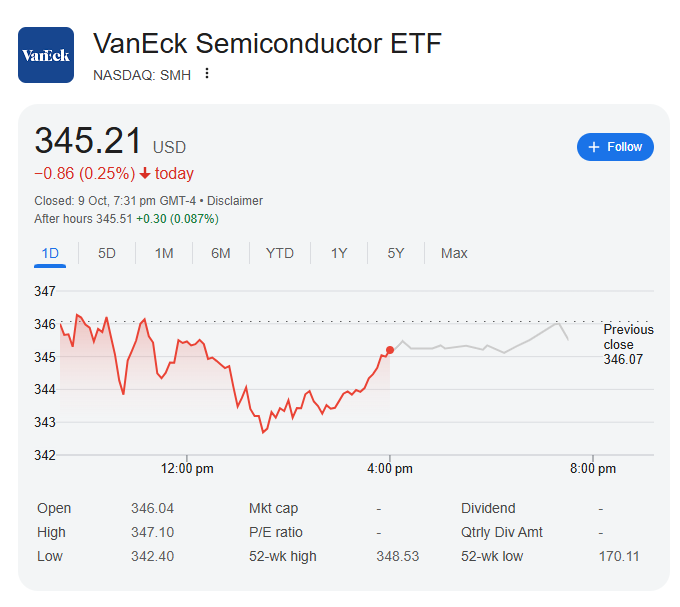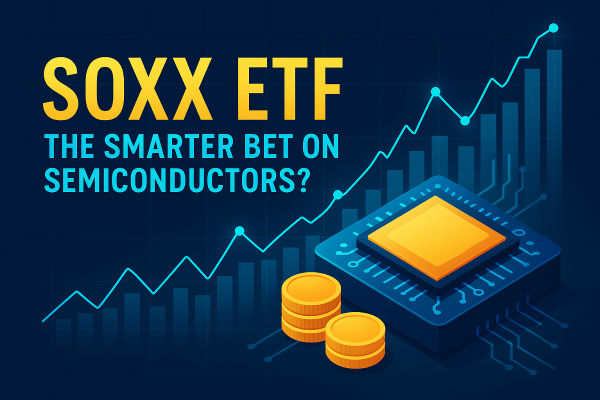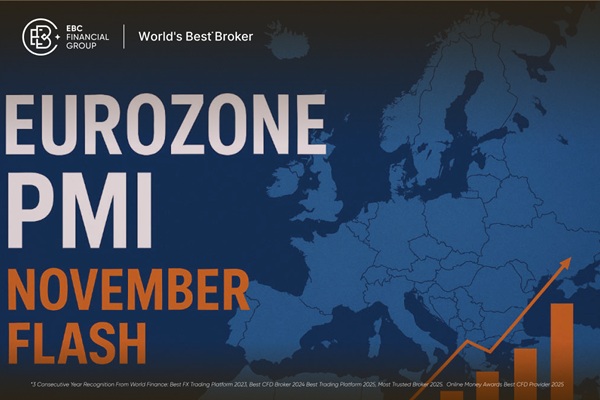Artificial intelligence has evolved from a laboratory curiosity into the engine of global growth. It writes our emails, designs our cities, and even manages our portfolios. Yet behind every AI application, from ChatGPT’s responses to Tesla’s autopilot, lies a physical foundation: semiconductors.
In 2025, semiconductors are the new oil of the digital age. They power data centres, supercomputers, and smartphones alike. As investors chase the next wave of AI-driven innovation, one instrument sits at the crossroads of this transformation: the VanEck Semiconductor ETF (SMH).
SMH does not just hold chip stocks; it tracks the entire architecture of the modern economy. But with valuations lofty, new AI ETFs appearing monthly, and competition intensifying, the question arises: is the SMH ETF still the smartest way to play artificial intelligence in 2025?

What Exactly Is the SMH ETF?
The SMH ETF follows the MVIS US Listed Semiconductor 25 Index, which includes 25 of the largest and most liquid semiconductor companies worldwide. It spans the full supply chain from chip designers to foundries, equipment makers, and material providers, making it one of the most complete reflections of the global semiconductor market.
Key Facts (as of October 2025)
Assets under management: USD 16.1 billion
Expense ratio: 0.35%
Average daily trading volume: about 5.2 million shares
Top 10 holdings: roughly 70% of fund weight
2025 YTD return: +28%
Dividend yield: 0.8%
Launch date: 2011
Its top holdings read like a roll call of the AI revolution: Nvidia, TSMC, Broadcom, AMD, ASML, Qualcomm, Intel, Micron, Texas Instruments, and Applied Materials.
In short, SMH offers a simple way to invest in the companies building the chips that build the future.
The Semiconductor Economy in 2025
After three years of volatility, the chip industry has entered a new growth cycle. The end of supply shortages has given way to massive reinvestment, while artificial intelligence, autonomous vehicles, and cloud computing have become dominant sources of demand.
Industry Highlights
Global semiconductor revenue: USD 620 billion in 2025, up from USD 545 billion in 2024 (SEMI data).
AI-specific chips: now 25% of total sales, worth roughly USD 155 billion.
Capital expenditure: more than USD 200 billion globally this year.
Fab construction: 23 new semiconductor plants scheduled to begin operations before the end of 2026.
Leading-edge nodes: 3-nanometre chips in mass production, 2-nanometre in pilot stage for 2026 release.
Company Performance
Nvidia: posted record quarterly revenue above USD 30 billion and net margins near 55%, the highest in the company’s history.
TSMC: utilisation of advanced nodes above 90%, driven by AI chips and automotive contracts.
ASML: backlog exceeding EUR 45 billion, a 20% year-on-year increase.
Micron: returned to profitability thanks to AI memory demand.
The Philadelphia Semiconductor Index (SOX) is up roughly 24% in 2025 compared to the S&P 500’s 7%. Unlike the speculative rallies of 2021, this surge is grounded in earnings growth and infrastructure expansion.
Recent Performance History of SMH
2020–2021: The Golden Rally
When the pandemic triggered an explosion in digital demand, SMH rose from USD 130 to over USD 320, a gain of more than 140%. Remote work, cloud computing, and cryptocurrency mining created once-in-a-generation chip shortages.
2022: The Downturn
As inflation surged and central banks tightened policy, technology valuations fell sharply. Semiconductor inventories rose, and SMH declined about 37%, bottoming near USD 200 in October 2022.
2023–2024: The AI Renaissance
By 2023, demand from data centres and AI training clusters reignited the sector. Nvidia’s dominance and TSMC’s efficiency pulled SMH up 70% through 2024, easily outperforming broader tech indices.
2025: The Year of Consolidation
In 2025, SMH has advanced another 28%, fluctuating between USD 210 and USD 280. Midyear volatility from profit-taking was offset by sustained AI hardware orders. Over the past five years, the ETF has returned roughly 200%, outperforming the Nasdaq 100 by nearly 70 percentage points.
This performance confirms SMH’s place as the benchmark for semiconductor exposure in global markets.
Why AI Drives Semiconductor Growth
Every AI model consumes extraordinary processing power. A single large language model may use over 20,000 GPUs during training and thousands more for inference tasks.
Two Growth Engines
Training Phase: Nvidia, AMD, and TSMC dominate production of high-performance GPUs and AI accelerators.
Inference Phase: Qualcomm, Broadcom, and Intel design efficient chips used in phones, vehicles, and cloud servers.
According to IDC, global AI hardware spending will exceed USD 250 billion by 2026, with chip demand growing at 18% annually. That demand channels directly into SMH’s underlying firms.
AI is not just a catalyst; it is the new baseline of semiconductor economics. Without AI, chip demand stagnates. With it, the market expands exponentially.
The Case for the SMH ETF
1. Pure Exposure to AI Infrastructure
SMH investors own the physical foundation of machine learning, not speculative software, but the silicon that makes AI possible.
2. Proven Historical Outperformance
From 2015 to 2025, SMH’s total return exceeded 440%, translating to an annualised rate of roughly 19%. That outpaces the Nasdaq 100 (approximately 14%) and S&P 500 (approximately 10%).
3. Exceptional Liquidity
Average daily turnover above USD 1 billion ensures tight spreads, making SMH suitable for both long-term positions and short-term trades.
4. Global Supply-Chain Coverage
Although listed in New York, SMH includes global leaders across Taiwan, South Korea, and Europe, providing genuine geographic diversification.
5. Strong Correlation with AI CapEx
When major cloud providers boost AI spending, SMH historically rises in tandem. The correlation between SMH and Nvidia’s share price over the past 24 months has averaged +0.84.
The Case Against SMH
1. Heavy Concentration
Two holdings, Nvidia and TSMC, account for more than 30% of the ETF’s total weight. A single earnings disappointment can have outsized impact.
2. High Valuations
At a 28x forward price-to-earnings ratio, SMH trades at a premium to the S&P 500’s 20x. Sustained growth is required to defend that multiple.
3. Cyclicality and Inventory Risk
Semiconductors remain subject to boom-and-bust cycles. A slowdown in AI infrastructure spending could trigger a correction.
4. Geopolitical Exposure
More than half of advanced chip production still occurs in Taiwan. Any disruption across the Taiwan Strait could ripple through SMH’s holdings.
Macro Outlook: 2025–2026
The macro backdrop supports sustained semiconductor demand but with moderating momentum.
IMF global growth forecast: about 3.3% for 2025 and 2026.
OECD industrial production growth: 2.8% globally, led by Asia.
AI hardware CapEx: set to surpass USD 250 billion by 2026 (IDC).
New fabrication capacity: expected to expand global chip supply by 15% over two years.
A key shift is regionalisation. The US and EU now account for over 25% of global fab investment, up from 18% in 2020, as governments push for domestic resilience.
For traders, this means SMH benefits from both top-line demand and state-backed policy tailwinds.
Trading and Investment Strategies
1. Long-Term Position Holding
Allocate 5 to 10% of an equity portfolio to SMH for exposure to AI hardware growth. The ETF’s breadth reduces single-stock risk.
2. Swing Trading During Earnings
Quarterly earnings cycles in Nvidia, AMD, and TSMC generate predictable volatility windows. Traders often buy near retracements and exit after post-earnings rallies.
3. Pair Trading
SMH versus QQQ remains a popular pair. When semiconductors outperform software, going long SMH and short QQQ can capture relative strength.
4. Hedging Broader Tech Exposure
SMH can serve as a hedge for software-heavy portfolios during hardware-led upcycles, or inversely, a short hedge during cyclical cooling.
5. CFD Trading
Contracts for Difference allow leveraged exposure in both directions, useful for tactical trading during volatile periods. Strict risk control is essential because SMH can move sharply within hours.
How to Trade SMH Effectively
Identify Trend Structure: Use daily or four-hour charts to spot pullbacks in established trends.
Confirm with Indicators: RSI and MACD divergence often signal short-term reversals.
Position Size Wisely: Limit exposure to 3% of capital per trade to absorb volatility.
Watch for Catalysts: Nvidia or TSMC earnings, Taiwan export data, and US policy updates move the ETF quickly.
Plan Exits: Technical resistance sits near USD 285 to 295; support around USD 240 to 245.
Trading SMH successfully means treating it as a barometer of AI sentiment, fast, powerful, but predictable within structure.
Future Outlook: 2026 and Beyond
Analysts expect the semiconductor industry to reach USD 720 billion in annual revenue by 2027, expanding 8 to 10% per year.
AI remains the central growth engine. TSMC and Samsung are on track to begin 2-nanometre process production in late 2026, improving performance and energy efficiency by 25%.
New entrants in memory and packaging, including SK Hynix and ASE Technology, are likely to join the MVIS index, giving SMH fresh exposure to emerging sub-sectors.
Long-term trends also include:
On-device AI growth: processors for smartphones and cars will form the next multibillion-dollar wave.
Chip diversification: beyond GPUs, custom ASICs and neuromorphic processors will broaden revenue streams.
Energy efficiency as constraint: data centres’ electricity use may reach 4% of global power demand by 2026, pushing innovation in low-power semiconductors.
Even if AI hype cools temporarily, hardware requirements will continue compounding as digitalisation deepens worldwide.
Risks to Watch
Export Controls: US restrictions on advanced chip sales to China could reduce addressable markets for Nvidia and AMD.
Interest Rates: If inflation resurges, higher yields could compress equity multiples.
Supply Glut: Overbuilding new fabs might trigger price competition in 2027.
Policy Shifts: Changes to subsidy frameworks could impact margins.
However, structural demand from AI, EVs, 5G, and defence computing provides strong downside resilience.
The Bigger Picture: Chips as the New Currency of Power
Semiconductors are no longer just an industry; they are a form of geopolitical leverage. Nations treat chipmaking capacity as a strategic asset. From Washington to Tokyo, policymakers now view control over advanced lithography and fabrication as vital to economic sovereignty.
This reality gives SMH’s composition added weight. It is not merely an ETF, but a snapshot of global industrial competition. Its returns mirror both corporate performance and the balance of technological power.

FAQs About SMH ETF
Q1. What does the SMH ETF invest in?
The SMH ETF focuses on leading semiconductor companies involved in chip design, manufacturing, and equipment supply. Its holdings include major names such as Nvidia, TSMC, AMD, and ASML, which collectively account for around 70% of its portfolio weight. This structure provides investors with diversified exposure across the full semiconductor value chain.
Q2. Why is the SMH ETF popular among AI-focused traders?
Because artificial intelligence requires massive computing power, demand for advanced chips has soared. The SMH ETF directly benefits from this trend since its largest constituents produce the hardware behind AI data centres and devices. This makes it one of the most efficient ways to gain exposure to the AI hardware boom without choosing individual stocks.
Q3. Is the SMH ETF risky to trade or hold?
Like most sector-focused funds, SMH carries concentrated exposure. It is heavily influenced by a few companies and global chip demand cycles. While it offers strong long-term potential, traders should be aware of its volatility, which can exceed 25% annually. Using disciplined position sizing and stop-loss strategies helps manage these risks effectively.
Conclusion
The SMH ETF stands at the centre of one of the most powerful investment themes of the decade. It captures the backbone of artificial intelligence, the semiconductors that make every algorithm possible.
For investors seeking pure exposure to AI hardware, SMH offers liquidity, diversification, and scale unmatched by newer thematic funds. Its volatility demands respect, but its structural growth potential remains undeniable.
In the balance of risk and innovation, SMH continues to be one of the smartest ways to play AI.
EBC Financial Group provides trading access to the SMH ETF and more than 100 US ETF CFDs, giving traders a direct route to engage with global technology sectors through a trusted platform.
Disclaimer: This material is for general information purposes only and is not intended as (and should not be considered to be) financial, investment or other advice on which reliance should be placed. No opinion given in the material constitutes a recommendation by EBC or the author that any particular investment, security, transaction or investment strategy is suitable for any specific person.























